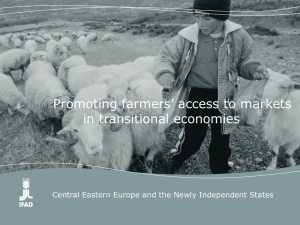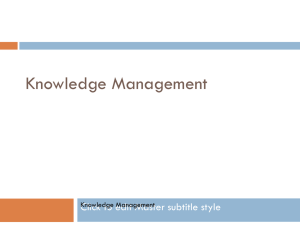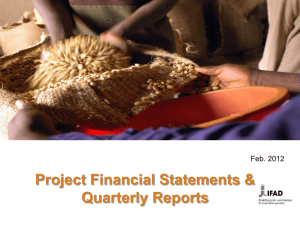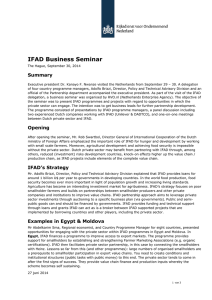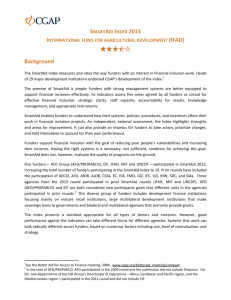Results Measurements Framework 2013-2015
advertisement
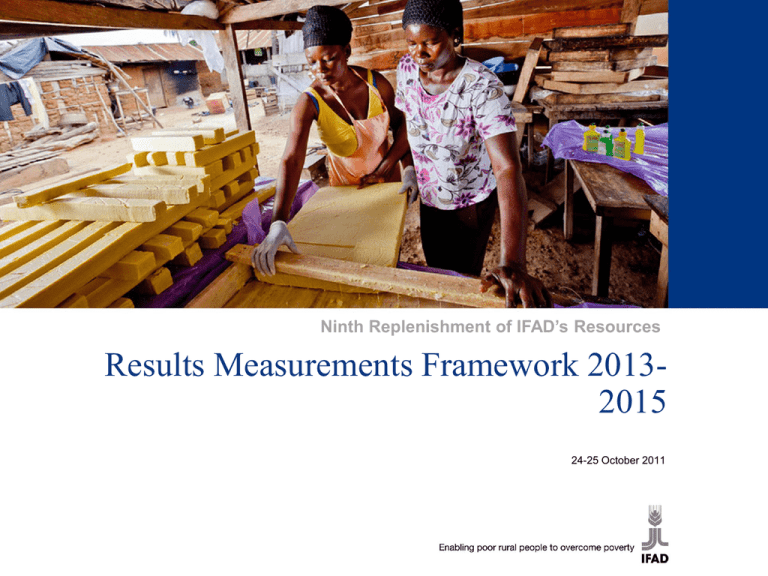
Ninth Replenishment of IFAD’s Resources Results Measurements Framework 20132015 24-25 October 2011 1 IFAD9 Priorities During IFAD9, priorities will be to: • Strengthen programmatic outcomes and impact (by enhancing efficiency of projects, effectiveness in achieving development objectives, impact on rural poverty, sustainability, & scaling up) • Enhance effectiveness of country programmes and projects (through improved integration of lending and non-lending instruments, enhanced project design, greater attention to fragile states, more proactive management of the on-going project portfolio) • Increase organizational effectiveness and efficiency (by increasing institutional cost-effectiveness, raising the share of resources dedicated to programme management, extending decentralization, and improving human resources management.) 2 3 Level 1: Macro level: overall global poverty reduction and agricultural development Level 2: IFAD’s contribution to development outcomes and impact at project/programme completion Level 3: Outputs of country programs and projects under implementation Level 4: Leading indicators of quality of design and implementation support for country programmes and project s Level 5: IFAD’s Organizational effectiveness and efficiency Attribution to IFAD Strengthens Outcome more relevant to IFAD Objectives Results Measurement Framework: the results chain IFAD’s RMF in the context of its operating model 4 What changes in IFAD9 ? • More focus on gender, nutrition, environment, climate change, private sector engagement, economic efficiency, innovation and scaling-up • Country leadership and in-country planning, reflected in COSOPs and projects • IFAD country offices to expand and take on more responsibility • Partnerships with all actors, also for cofinancing • Better monitoring and reporting on results, especially at outcome and impact levels 5 Global poverty and agricultural development outcomes (Level 1) Existing indictors: only baselines and targets updated Indicators 1.1. Global poverty and nutrition outcomes 1.1.1 MDG 1: Population living on less than US$1.25 a day (per cent)a MDG 1: Prevalence of undernourishment in population (per cent)a 1.1.2 1.1.3 MDG 1: Children under 5, per cent underweight 1.2. Global agricultural development and investments outcomes 1.2.1 Crop production index (1999-2001 = 100)b 1.2.2 Agricultural value added (annual percentage growth)b 1.2.3 Level of official development assistance to agriculture 1.2.4 Share of budget allocated to agriculture and rural development 6 Source Baseline year Baseline value Target for 2015 World Bank 1990 42 21 World Bank 2005-2007 16 10 World Bank 2008 26 17 World Bank 2007 117 Tracked World Bank 2007 4 Tracked World Bank 2008 US$4.9 billion Tracked World Bank 2008 19% Tracked Global poverty and agricultural development outcomes (Level 2) Existing indicators: only baselines and targets updated a, b 7 Refers to percentage of IFAD financed projects rated at moderately satisfactory or better at completion point. IFAD’s contribution to development outcomes and impact (level 2) cont’d. New or modified indicators for the 9th Replenishment Indicators Source Baseline year Baseline value (%) Target for 2015 (%) 2.1. Impact Indicators (new) 2.1.1 Innovation and learning (modified) PCR 2010 86 90 2.1.2 Replication and scaling-up (modified) PCR 2010 85 90 2.1.3 Environment and natural resource management (new) PCR 2010 88 90 2.1.4 Government performance (new) PCR 2010 73 80 2.2.1 Household asset ownership index (new) RIMS - - Tracked 2.2.2 Level of child malnutrition (3 sub-indicators - acute, chronic and underweight), disaggregated for girls and boys (new) RIMS - - Tracked 2.2.3 Length of hungry season (new) RIMS - - Tracked 2.3. People moved out of poverty RIMS/ sample impact surveysb/ 2010 36 million 50-100 (a) million 2.3.1 People moved out of poverty (new) (a) Responding on level of replenishment (b) Methodology being worked out. Preliminary discussion with IFPRI was held recently. 8 IFAD's contribution to country programme and project outputs (level 3) Most indicators retained, 2 additional indicators (3.7 and 3.8) 9 IFAD's contribution to country programme and project outputs (level 3) cont’d. Existing indicators: only baselines and targets updated 10 Operational effectiveness of country programmes and projects (level 4) Existing indicators: only baselines and targets updated Indicators 4.1 Country programme quality at entry 4.1.1 Percentage of RB-COSOPs rated 4 or bettera 4.2 Percentage of country programmes rated 4 or better during implementation for: 4.2.1 Contribution to increased incomes, improved food security, and empowerment of poor rural women and men 4.2.2 Adherence to the aid effectiveness agenda 4.3 Percentage of projects rated 4 or better at entry 4.3.1 Gender 4.4 Portfolio management 4.4.1 Time from project approval to first disbursement (months) e Source Baseline year Baseline value (%) Target for 2015 (%) COSOP QAb 2010 100 100 Client survey 2011 78 90 CPISc 2011 93 100 QA 2010/11 86 90 PPMSd 2010/2011 17 14 4.4.2 Proactivity index PPMS 2010/2011 50 75 4.4.3 Projects at risk PPMS 2010/2011 18 15 4.4.4 Project time overrun (percentage) PPMS 2010/2011 22 18 4.4.5 Time for withdrawal application processing (days) PPMS 2009/2010 28 20 4.4.6 Percentage of projects for which IFAD performance is rated moderately satisfactory or better ARRI 2009/10 71 80 a Earlier score of 4 or better, converted into percentage; a cut-off score of 4 or above indicates a positive rating. IFAD uses more nuanced ratings (5 and 6) for internal monitoring purposes. b Quality assurance (QA) ratings provided for each project prior to submission for approval by the Executive Board. c Country programme issue sheet. d Generated by the Project Portfolio Management System. e Percentage of problem projects for which corrective actions are taken. 11 Operational effectiveness of country programmes and projects (level 4) cont’d. New or modified indicators Indicators Source Baseline year Baseline value (%) Target for 2015 (%) 4.2 Percentage of country programmes rated 4 or better during implementation for: 4.2.1 Engagement in national policy dialogue (new) Client survey 2011 55 70 4.2.2 Partnership-building (new) Client survey 2012 TBD TBD 4.3 Percentage of projects rated 4 or better at entry 4.3.1 Overall average (new) QA 2010/11 79 85 4.3.2 Overall average for projects in fragile states only (new) QA 2010/11 n/a 80 4.3.3 Monitoring and evaluation (new) QA 2010/11 70 80 4.3.4 Percentage of projects receiving positive ratings on scaling-up (modified) QA 2010/11 72 80 4.4 Portfolio management 4.4.1 Percentage disbursement ratio (new) PPMS mid-2011 15.7 18 4.5 Project monitoring and evaluation 4.5.1 Percentage of projects with RIMS or equivalent baseline surveys (cumulative percentage) (new) office records Mid-2011 23 40 office records Mid-2011 70 95 PCR review 2010-11 80 90 (a) 4.5.2 Percentage of projects submitting RIMS impact survey (new) 4.5.3 PCR quality (percentage rated 4 or better) (new) (a) On selective basis, randomized control trials (RCTs) or similar vigorous methodology will be applied. 12 Organizational effectiveness and efficiency (level 5) Existing indicators: only baselines and targets updated 13 Organizational effectiveness and efficiency (level 5) cont’d. New or modified indicators for the 9th Replenishment 14 Organizational effectiveness and efficiency (level 5) cont’d. New or modified indicators for the 9th Replenishment 15 IFAD data sources and reporting Result areas Data sources Level 1: Global poverty reduction Millennium Development Goals Report, World Development Report, Human Development Report Level 2: Outcomes & impact Project completion reports; RIMS; selective rigorous impact evaluations, also using randomized control trials (RCTs) Level 3: Project outputs RIMS, supervision reports Level 4: Operational effectiveness Quality assurance review, PPMS, client survey, supervision reports, annual portfolio reviews Level 5: Organizational effectiveness &efficiency Internal performance reports, staff survey Main reporting vehicles: RIDE & ARRI for the EB. Management will also use the Annual Portfolio Review Report and Quarterly Performance Conversations. 16 Thank you! 17



